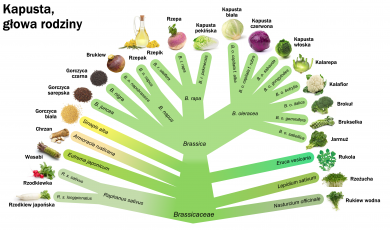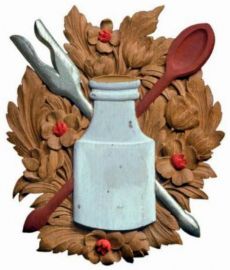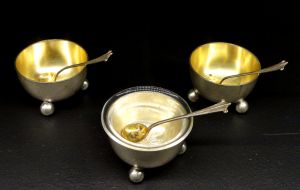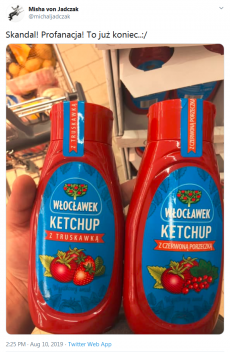Keczup czy musztarda?: Różnice pomiędzy wersjami
| Linia 490: | Linia 490: | ||
A co z keczupem? Wybrałem angielski przepis z początku XIX w., który ma cechy przejściowe: już zawiera pomidory, ale jeszcze zawiera ryby – a konkretnie sardele, zwane też z francuska ''anchois''. | A co z keczupem? Wybrałem angielski przepis z początku XIX w., który ma cechy przejściowe: już zawiera pomidory, ale jeszcze zawiera ryby – a konkretnie sardele, zwane też z francuska ''anchois''. | ||
{{ Cytat | |||
| Zbierz jeden galon dobrych, czerwonych, w pełni dojrzałych pomidorów. Utłucz je z jednym funtem soli i zostaw na trzy dni, wyciśnij sok i na każdą kwartę soku dodaj ćwierć funta sardeli, dwie uncje szalotek oraz jedną uncję zmielonego czarnego pieprzu. Gotuj to razem przez pół godziny, przecedź przez sito i dodaj następujących przypraw: ćwierć uncji kwiatu muszkatołowego, po tyle samo ziela angielskiego i imbiru, pół uncji gałki muszkatołowej, jedną drachmę ziaren kolendry, pół drachmy koszenili. Utłucz wszystko razem i trzymaj na wolnym ogniu przez dwadzieścia minut, po czym przecedź przez worek. Po ostygnięciu przelej do butelek, dodając do każdej butelki kieliszek brandy. Wytrzyma przez siedem lat. | |||
| oryg = Gather a gallon of fine, red, and full ripe tomatas; mash them with one pound of salt; let them rest for three days, press off the juice, and to each quart add a quarter of a pound of anchovies, two ounces of shallots, and an ounce of ground black pepper; boil up together for half an hour, strain through a sieve, and put to it the following spices; a quarter of an ounce of mace, the same of allspice and ginger, half an ounce of nutmeg, a drachm of coriander seed, and half a drachm of cochineal; pound all together; let them simmer gently for twenty minutes, and strain through a bag: when cold, bottle it, adding to each bottle a wineglass of brandy. It will keep for seven years. | |||
| źródło = | |||
}} | |||
== Ilustracje == | == Ilustracje == | ||
Wersja z 08:42, 8 cze 2020
Sezon grilowy, który w Polsce tradycyjnie zaczyna się w święta majowe, jest już w pełni. To dobra okazja, by zająć się dwoma dodatkami, które na imprezie grilowej są nieodzowne: musztardą i keczupem.
Musztarda – „niepospolity kondyment”
Zacznijmy od musztardy, bo to przyprawa o zaiste starożytnym rodowodzie. Jeśli wyjmiemy z lodówki słoik z musztardą i przeczytamy podany na etykiecie skład, to zobaczymy, że składa się przede wszystkim z ziaren gorczycy, octu, soli i cukru. Skład na tyle prosty, że można bez większego trudu zrobić sobie własną musztardę w domu (o czym później), a co więcej, przez stulecia raczej się nie zmienił. Najważniejsza w tym składzie jest oczywiście gorczyca, więc najpierw kilka słów o niej.

Gorczyca to taka roślinka, podobna z wyglądu do rzepaku, czyli kwitnąca na żółto, której ziarenka mają charakterystyczny smak… No właśnie, jaki? Nazwa sugerowałaby, że gorzki, ale one są raczej słodkawe, a przede wszystkim ostre. Świeżo rozgryzione ziarenka smakują trochę jak bardzo mocna rzeżucha. A zatem skąd nazwa? Prawdopodobnie zarówno „gorczyca” jak i „gorzki” pochodzą od słowa „gorzeć”, czyli „palić”. Wydaje się, że adekwatnie, bo smak gorczycy można faktycznie opisać jako palący.
Gorczyca występuje w trzech odmianach: białej, czarnej i sarepskiej, czyli brązowej. Co ciekawe, czarna i sarepska są bliżej spokrewnione z kapustą niż z gorczycą białą, ale proponuję, żeby nie przejmować się tu botaniczną taksonomią i wszystkie trzy nazywać jednak nadal „gorczycą”.
Gorczyca jest znana ludzkości od dawna, a za przykład można tu podać chociażby Jezusowe porównania królestwa Bożego do ziarnka gorczycy.
| Do czego podobne jest królestwo Boże i z czym mam je porównać? Podobne jest do ziarnka gorczycy, które ktoś wziął i posadził w swoim ogrodzie. Wyrosło i stało się wielkim drzewem, tak że ptaki powietrzne gnieździły się na jego gałęziach. | ||||
— Jezus z Nazaretu, cyt. w: Ewangelia według św. Łukasza, rozdz. 13, wersy 18–19; w: Biblia Tysiąclecia Online, Poznań: Wydawnictwo Pallottinum, 2003
Tekst oryginalny:
|
Ale zaraz, jak drzewem? Gorczyca to roślina jednoroczna, nie wyrasta na więcej niż 60 cm wysokości. To Jezusowi się pomyliło, Łukasz coś pokićkał czy tłumacz przeinaczył?
Tak czy siak, starożytni Rzymianie wymyślili, że ostry smak gorczycy można nieco złagodzić mieszając go z kwaśnym moszczem winnym. Mieszankę tę nazywali „palącym moszczem”, czyli „mustum ardens”, z czego, jak łatwo się domyślić, pochodzi słowo „musztarda”. Przyprawa ta przyjęła się na tyle, że przetrwała nawet upadek Imperium Rzymskiego i w średniowiecznej Europie była na porządku dziennym, z tym że moszcz winny coraz częściej zastępowano sokiem z niedojrzałych winogron albo – tak jak dzisiaj – octem (choć np. słynną musztardę z Dijon nadal robi z białego wina). Co nie znaczy, że średniowieczni Europejczycy nie mieli swoich stereotypów na temat tego, które narody kochają musztardę bardziej niż inne, czego najlepszym przykładem jest wiersz Eustachego Deschamps, XIV-wiecznego prekursora francuskiego szowinizmu kulinarnego, któremu nie smakowało nic poza granicami Francji. Jego niezbyt pochlebny opis kuchni czeskiej już kiedyś cytowałem, teraz pora na wiersz o gastronomii belgijskiej (ten też w moim przekładzie).

Czy to w Hanonii, czy w Brabancji, | ||||
— Eustache Deschamps: Tousjours, sanz demander, moustarde, w: Selected Poems, red. Ian S. Laurie, Deborah M. Sinnreich-Levi, New York – London: Routledge, 2003, s. 116, tłum. własne
Tekst oryginalny:
|

A kiedy musztarda dotarła do Polski? Pewnie też już w średniowieczu, choć pierwsze wzmianki pisane na jej temat pochodzą dopiero z XVII w. Oto co pisał o niej Szymon Syreński, słynny polski lekarz i botanik:
| Z gorczycy czynią przysmak bardzo osobliwy i zdrowy, którego pospolicie używają przy stole, zwłaszcza czasów zimnych. Ten przysmak zowią właśnie u nas „gorczyczka”, z cudzoziemska „mustarda”, którą każdy według swej woli i upodobania czyni […] Jedni po prostu wiercą nasienie gorczyczne co najświeższe […], a uwierciszy go w donicy, winem słodkim a miodem roztwarzają. Drudzy kładą cukier a octem rozpuszczają. Inni skórki pomarańczowe w miodzie przyprawione drobno siekają i w mostardę kładą, które smak osobliwy czynią. Niektórzy z gdulami [t.j. gruszkami] albo z da[k]t[y]lami z skórek i z błonek swych ochędożonymi, jako z pigwami, przyprawują, przydając cynamonu, goździków […] |
| — Szymon Syreński: Zielnik herbarzem z języka łacińskiego zowią, Kraków: 1613, s. 1205; cyt. w: Jarosław Dumanowski: Staropolskie przepisy kulinarne: Receptury rozproszone z XVI–XVIII w.: Źródła drukowane, Warszawa: Muzeum Pałacu Króla Jana III w Wilanowie, 2016, s. 305 |
Widać więc, że od początku musztarda istniała u nas w całej gamie odmian, pewnie nawet bogatszej niż dzisiejszy wybór: delikatesowa, francuska, rosyjska, sarepska, chrzanowa, miodowa. Co prawda, w Compendium ferculorum Stanisława Czernieckiego, czyli najstarszej wydanej drukiem polskiej książce kucharskiej, pojawia się tylko jeden przepis na ów „niepospolity condiment” (oprócz gorczycy wymaga wina, octu, gruszek, rodzynek i cukru)[1], ale w innych staropolskich poradnikach można znaleźć ich więcej. Co ciekawe, większość z nich była na słodko. I może nie powinna dziwić sama słodkość, bo w końcu i dzisiaj popularna jest musztarda miodowa, ale zaskakiwać może różnorodność słodkich dodatków. Najciekawszy dla mnie jest XVIII-wieczny przepis na musztardę z dodatkiem gruszek i miodownika (czyli mocno miodowego piernika), który znajdziecie na końcu wpisu.
Wraz z rozwojem receptur na musztardę rozwijały się też sposoby jej eleganckiego podania na stole. Pamiętacie Mickiewiczowski opis soplicowskiego serwisu stołowego? Według Jędrzeja Kitowicza nieodzownym elementem takiego serwisu były „bańki” osadzone w metalowych obrączkach przylutowanych do pionowych elementów konstrukcji.

| W każdej z tych obrączek stała wetkniętą bańka misterna z nakrywadłem srebrna, albo też kryształowa srebrem w kilkoro obwiedziona; te bańki […] dlatego osadzone były w […] obrączki, ażeby nie podlegały nieostrożnemu wywróceniu. Służyły zaś do octu, oliwy, cukru […] i musztardy, których ingrediencji panowie zażywali, gdy […] jakiej potrawie smaku lepszego podług dotkliwości języka swego przydać chcieli; musztardę zaś brali do sztuki mięsa i kiełbasy pieczonej, z którą kiełbasę sądzili być zdrowszą i smaczniejszą. […] W bańce z musztardą była łyżeczka proporcjonalna do bańki z trzonkiem zakrzywionym, głęboka jak wiaderko, srebrna, w środku wyzłacana […] Bańki z oliwą i octem kto potrzebował, odkrył przykrywadło i nalał sobie likworu łatwo ciekącego. Że zaś musztarda, jako gęściejsza, nie tak łatwy ciek miała, dlatego do niej przydawano łyżkę, bez której nalewający musztardy, albo by za zbytnim nachyleniem bańki razem wiele nalał, albo za małym długo by ciągnącej się masy powoli czekał. |
| — O stołach i bankietach pańskich, w: Jędrzej Kitowicz: Opis obyczajów i zwyczajów za panowania Augusta III, t. 3, Poznań: Edward Raczyński, 1840, s. 165–167 |
Keczup – „coś w rodzaju kabulu”

W sierpniu zeszłego roku na portalu Wirtualna Polska pojawił się artykuł pt. „Truskawkowy keczup od firmy Włocławek: Internauci w szoku”. Jak przystało na nowoczesne dziennikarstwo, artykuł ten był w całości oparty na dwóch wpisach na Twitterze. W jednym z nich, opublikowanym przez pana Michała Jadczaka, było zdjęcie dwóch plastikowych butelek – jednej z „ketchupem z truskawką”, drugiej – „z czerwoną porzeczką”. Fotografia była opatrzona podpisem: „Skandal! Profanacja! To już koniec..:/” (interpunkcja oryginalna). Liczne komentarze innych użytkowników Twittera potwierdzały szok, jaki wywołała wiadomość o dodawaniu do keczupu owoców innych roślin niż pomidor, ewentualnie wiązały ten skandal z doniosłym faktem, iż keczup marki Włocławek nie jest już produkowany we Włocławku.
Jeśli Was również keczup truskawkowy szokuje, to co powiecie na keczup grzybowy? Albo orzechowy? Ostrygowy? Pochodzenie keczupu, jak się okazuje, jest nie mniej starożytne niż musztardy, ale podczas gdy mustum ardens sprzed wieków rozpoznalibyśmy i dzisiaj jako musztardę, to keczup długo ewoluował, zanim stał się gęstym, jednolicie czerwonym i słodkim sosem pomidorowym, który znamy dzisiaj.
Otóż keczup rozpoczął swoją karierę gdzieś w Azji Południowo-Wschodniej, w charakterze… sosu rybnego. Krew i wnętrzności wypatroszonych ryb, jak też małe rybki bez innego zastosowania gospodarczego, solono i pozostawiano, by sfermentowały. Smród musiał przy tym być niesamowity, ale tylko na początku produkcji. W miarę, jak ta mieszanka fermentowała, zapach robił się coraz łagodniejszy, a smak przyjemniejszy. Powstawał w ten sposób płyn będący naturalnym źródłem glutaminianu sodu – inaczej mówiąc, coś w rodzaju magi. W północnowietnamskim dialekcie języka chińskiego taki sos nazywano „kê-tsiap”.

Co ciekawe, tego rodzaju sos rozpowszechnił się głównie na południu Chin, na Półwyspie Indochińskim i w Indonezji, ale bardziej na północ − w większej części Chin, w Korei i w Japonii − już nie. Dlaczego? Bo na północy istniał prostszy w produkcji odpowiednik: sos sojowy. Natomiast sos rybny produkowano dawniej również nad Morzem Śródziemnym. W starożytnym Rzymie produkcja różnych sosów z fermentowanych ryb (takich jak liquamen, którego używano w kuchni, oraz garum, który stosowano jako przyprawę stołową) to był poważny biznes. W Barcelonie zwiedzałem kiedyś ruiny fabryki takich sosów, które leżą tuż obok ruin starożytnej winiarni. A więc obok siebie produkowano moszcz, z którego wyrabiano protoplastę dzisiejszej musztardy, i sos rybny podobny do tego, z którego wywodzi się keczup.
Niestety znajomość rzymskiej techniki produkcji sosu rybnego, w przeciwieństwie do musztardy, zaczęła popadać w zapomnienie wraz z upadkiem rzymskiej cywilizacji (trochę dłużej przetrwała w Bizancjum). We Włoszech garum zostało wyparte przez nieco inny przysmak, robiony z solonej, fermentowanej i prasowanej ikry, zwany bottarga. Trzeba było poczekać do epoki wielkich odkryć geograficznych, żeby zachodni Europejczycy mogli na nowo zetknąć się z sosami rybnymi.
Ale zanim Anglicy po raz pierwszy napotkali w Indonezji coś, co miejscowi nazywali „kecap” (wym. keczap), to słowo zdążyło już rozszerzyć znaczenie na wszystkie sosy; dzisiejsi Indonezyjczycy nazywają tak głównie sos sojowy. Anglicy przejęli ów wyraz na oznaczenie wszelkich przetworów z długim czasem trwania. W przeciwieństwie do sosów, które na bieżąco przyrządzano do konkretnego dania, ketchup bądź catsup (angielska pisownia dotąd się nie ustandaryzowała) butelkowano i chowano w spiżarni na długie miesiące, a nawet lata. Pewna brytyjska książka kucharska z XVIII w. podawała nawet przepis na rybno-grzybowo-piwny katch-up mający wytrzymać dwadzieścia lat.[3] Oprócz rybnych i grzybowych były też popularne keczupy ostrygowe oraz z niedojrzałych orzechów włoskich, ale zachowały się też przepisy na keczupy ogórkowe, śliwkowe, agrestowe, cytrynowe, gronowe, brzoskwiniowe, paprykowe, fasolowe, homarowe, wątróbkowe, omułkowe, a nawet keczup śledziowy, który muszę kiedyś wypróbować. Co je wszystkie łączyło? Zawartość środków konserwujących, najczęściej soli oraz octu, czasem zastępowanego mocnym winem, wygazowanym piwem lub cydrem, oraz egzotycznych przypraw, jak imbir, gałka muszkatołowa czy goździki.
| Weź zielonych jeszcze orzechów włoskich, ubij je dobrze w moździerzu i odcedź z nich sok. Odstaw na dwanaście godzin, po czym do kwarty [ok. litra] soku dodaj sześć drobno posiekanych śledzi z odrobiną solanki, w której się moczyły. Mieszaninę włóż do rondla, dodaj odrobinę kwiatu muszkatołowego, około dwudziestu goździków i pół uncji [ok. 15 g] ziela angielskiego. Gotuj to wszystko na wolnym ogniu przez pół godziny, potem odcedź przez chustę i włóż z powrotem do rondla, dodając od dwudziestu do trzydziestu szalotek oraz pintę [ok. pół litra] octu. Gotuj, aż szalotki zmiękną, po czym wstaw rondel do misy z wodą, żeby go schłodzić. Schłodzoną mieszaninę odcedź przez chustę i zabutelkuj na później. | ||||
— Excellent Catsup, w: Richard Alsop: The Universal Receipt Book or Complete Family Directory by a Society of Gentlemen in New York, New York: I. Riley, 1814, s. 249; cyt. w: Andrew F. Smith: Pure Ketchup: A History of America's National Condiment, with Recipes, Columbia, SC: University of South Carolina Press, 1996, s. 163, tłum. własne
Tekst oryginalny:
|
Wydaje się, że w XVIII w. keczup był już dość dobrze zadomowiony w całym Imperium Brytyjskim. Jonathan Swift, znany głównie jako autor Podróży Guliwera, podał „catsup” jako jeden z przykładów swojskiego, brytyjskiego jadła, przeciwstawionego francuskim „zupom i frykasom”, w jednym ze swoich satyrycznych wierszy. Ale z drugiej strony, keczup pojawia się tam w jednej linijce kawiorem i wspomnianą już botargą, co pokazuje, że nadal był klasyfikowany razem z owocami morza. Oto fragment owego wiersza, poświęcony bogini łakomstwa, w moim przekładzie:
Żarłoczność tedy z swą łapą tłustą | ||||
— Jonathan Swift: Panegyric on the Dean in the Person of a Lady in the North, w: The British Poets, t. XXXVIII, Chiswick: Press of C. Whittingham, 1822, s. 116–117, tłum. własne
Tekst oryginalny:
|
Jeśli keczup można było robić praktycznie ze wszystkiego, to ktoś w końcu musiał wymyślił, żeby robić go z pomidorów. Tylko kto? Pomidory nie należą do rodzimej flory ani Indonezji, ani Wysp Brytyjskich. Europejczycy, którzy zetknęli się z pomidorami wraz z odkryciem Ameryki, długo nie mogli się do nich przekonać, bo dzikie pomidory z wyglądu najbardziej przypominały im wilczą jagodę, lulecznicę i tym podobne rośliny silnie trujące. Logiczne zatem, że pomysł na keczup pomidorowy pojawił się na kontynencie, z którego pomidor pochodzi, czyli w Ameryce. W nowo powstałych Stanach Zjednoczonych Ameryki tomato ketchup był już na przełomie XVIII i XIX w. popularnym kondymentem. Tak jak do innych keczupów, dodawano do niego octu, alkoholu, ostrych przypraw, a od lat 40. XIX w. – również jako środek konserwujący – cukru. W smaku zaczął więc przypominać keczup, jaki znamy dzisiaj. A z wyglądu? Dawne odmiany pomidorów były żółte (zresztą stąd ich nazwa: „pomo d'oro” to po włosku „złote jabłko”); do tego keczup często filtrowano tak, by zamiast gęstego sosu otrzymać rzadki żółtawy płyn.
Na ziemiach polskich keczup pojawił się stosunkowo późno, a jeszcze więcej czasu trzeba było, zanim Polacy go polubili. Mniej więcej w połowie XIX w. w warszawskich gazetach zaczęły pojawiać się reklamy importera różnorakich pikli i sosów angielskich, w tym również keczupu (orzechowego). Jego nazwa zapisana była po angielsku (choć z błędami) i wyraźnie traktowana jako coś nad Wisłą zupełnie egzotycznego.
| Pekeflejsz, ozory wędzone i Schlak-Wurst Hamburskie, jakoteż świeże Mixed Picle, Picca-lilly, Salad Cream, Beefsteak Sauce, India Soya, John Bull Sauce, Wallnut Ketchup, Toniatta, i wiele innych; Sardynki w mniejszych i większych puszkach, Ser angielski Chester, nadeszły Koleją żelażną, i nabyć ich można w handlu A. Koelichen przy ulicy Długiej […] |
| — Reklama delikatesów Koelichena, w: Kurier Warszawski, 132, Warszawa: 23 maja 1850, s. 702 (pisownia oryginalna) |
W 1885 r. pewien propagator nowoczesnego rolnictwa próbował zaszczepić w Polsce znajomość wyrobu keczupu jako sposobu konserwacji owoców i warzyw. Przy okazji zaproponował urocze spolszczenie angielskiego terminu na „kwasób”. Widać, że keczup, jaki on znał, nadal był rzadkim kwaśnym sokiem, a nie gęstym ulepkiem.
| Soki owocowe są dwojakie. Jedne są mniej lub więcej cukrzone i służą do zaprawienia napojów, np. wody, herbaty i wódki, tudzież potraw mącznych i do robienia lodów. Drugie są mniej lub więcej octem zaprawione i służą do potraw mięsnych. Ten rodzaj soków jest przez Anglików i Amerykanów używany i nazywa się keczup. Dla rozróżnienia […] zostawmy [drugim] ich nazwę angielską, zmienioną z keczup na kwasób. […]
Kwasób bywa pomidorowy, orzechowy lub ogórkowy. Każdy keczup angielski jest mocno octem, solą, pieprzem, papryką, niektóry zarazem gorczycą lub imbirem, gałką muszkatową itp. przyprawiony. |
| — Józef Bohdan Rogojski: Owocarstwo, czyli Nowe sposoby użytkowania z owoców drzew owocowych w klimacie naszym wzrastających, Warszawa: Wydawnictwo Przeglądu Tygodniowego, 1885, s. 65, 67 |
Moim zdaniem, wielka szkoda, że „kwasób” się w polszczyźnie nie przyjął. Zamiast niego mamy nie do końca przyswojoną pożyczkę z angielskiego, którą nie wiadomo, jak pisać („ketchup” czy „keczup”?) ani jak czytać (keczup czy keczap?). Jeszcze przez dużą część XX w. było to słowo mało w Polsce znane. Rozmówki polsko-angielskie z 1903 r. tłumaczą wyrażenie „fried oysters with ketchup” (wymowa podana w rozmówkach: freijd ejsters uidz keczepp) jako „ostrygi pieczone z rajskimi jabłuszkami”.[4] Tu najwyraźniej nie tylko „keczup”, ale i „pomidor” został uznany za słowo jeszcze dla przeciętnego Polaka niezrozumiałe.
W okresie międzywojennym keczup pomidorowy (i jego reklamy) był już w Stanach Zjednoczonych na porządku dziennym. Jeśli wierzyć korespondentowi jednej z ówczesnych polskich gazet, w Ameryce wszelkie potrawy były zalewane keczupem w takich ilościach, że wszystkie smakowały dokładnie tak samo.
| Wszystkie mięsiwa przyprawia się jednakowo, do wszystkich dodaje się niesłychane ilości pieprzu i nieodzownego, reklamowanego sosu „Chili” lub „Ketchup”. Gdyby wam nawet podano tak pyszną w zasadzie potrawę jak kaczka pieczona z pomarańczami, dowiecie się o tym, że jest to kaczka, tylko z karty potraw, w smaku kaczka nie będzie się niczym różniła od innych ochłapów tonących w reklamowanych sosach i przyprawach. |
| — Kłopoty gastronomiczne w kraju dolara: w Ameryce nie wszystko jest dobre, w: ABC – Nowiny Codzienne, nr 215, Warszawa: Mazowiecka Spółka Wydawnicza, 29 lipca 1935, s. 6 |

Ale międzywojnie to czas, kiedy keczup nie tylko bywał także w Polsce coraz częściej reklamowany, ale pojawili się też jego pierwsi krajowi producenci. Twórcą pierwszego przemysłowo wyrabianego keczupu w Polsce był Stanisław Fenrych, założyciel przetwórni owocowo-warzywnej w Pudliszkach. Majątek w Pudliszkach, należący wcześniej do Hermanna Kennemanna (współzałożyciela tzw. Hakaty, której celem była germanizacja ziem polskich pod zaborem pruskim) kupił Fenrych w 1919 r. i pozakładał w nim sady owocowe, ogrody warzywne i zakłady przerabiające płody rolne na marmolady, konfitury i konserwy. Firmowa legenda głosi, iż sąsiedzi wieszczyli, że prędzej gruszki na wierzbie wyrosną, niż te inwestycje przyniosą zysk, i dla tego Fenrych przekornie umieścił wierzbę z gruszkami w logotypie swojej firmy. W 1927 r. Fenrych wysłał swoich doradców, w tym prof. Tadeusza Chrząszcza z Uniwersytetu Poznańskiego, do Wielkiej Brytanii po nasiona pomidorów, uważając, że odmiany uprawiane na Wyspach powinny też dać radę w polskim klimacie. Doradcy oprócz nasion przywieźli też przepis na keczup pomidorowy. Jego przemysłową produkcję w Pudliszkach rozpoczęto już w kolejnym roku. W 1929 r. Pudliszki wizytował prezydent Ignacy Mościcki, któremu jako przekąskę przed obiadem podano jajka na twardo z keczupem.[5]
Pomysł wyrabiania keczupu pomidorowego szybko podchwycili inni przedsiębiorcy wielkopolscy, co widać po zamieszczanych w lokalnej prasie reklamach.
| Zakłady Przemysłowe Przetworów Żywnościowych znajdują się w rękach wytrawnego fachowca, p. Wincentego Paetza, jedynego właściciela. Przedsiębiorstwo to produkuje najprzedniejszy ocet naturalny pod prawnie zastrzeż. nazwą „Pecowin”, octy winne, musztardę, soki owocowe, kapustę kiszoną, ogórki w beczkach i konserwy jak: sterylizowane ogórki w puszkach, wyśmienity sos pomidorowy „Tomato-ketchup”, ekstrakty pomidorowe, grzybki marynowane w słoikach i puszkach, pikle i korniszony. Jest to przedsiębiorstwo chrześcijańskie i polskie. |
| — Reklama Zakładów Przemysłowych Przetworów Żywnościowych Wincentego Paetza, w: Rewja Mód, nr 3, Poznań: Jan Lange, 1935, s. 14 |
Przedwojenna prasa zaczęła też zamieszczać przepisy na „ostry sos pomidorowy na zimę tak zwany katsup lub keczup”[6] dla amatorów domowego przetwórstwa. Zresztą również za niemieckiej okupacji taki sposób konserwowania pomidorów propagowały w Generalnym Gubernatorstwie hitlerowskie gadzinówki.
| Z sosów polecić mogę prawie wcale u nas nieznany „keczup”, coś w rodzaju kabulu. Bierzemy 6 kg pomidorów możliwie najbardziej dojrzałych i rozgotowujemy je zupełnie, dusząc bez wody. Następnie przecieramy przez sito i dodajemy: 2 łyżki soli, filiżankę cukru, łyżeczkę papryki, łyżeczkę tłuczonego pieprzu, ziela, listka, cynamonu, goździków, kwiatu muszkatołowego i imbiru. Część tych korzeni można w ostateczności pominąć. Wszystkie te korzenie kładziemy w muślinowy woreczek i gotujemy w litrze octu. Pomidory po dobrym zgęstnieniu (około 5 godzin gotowania) mieszamy z wywarem octu z korzeniami i gotujemy jeszcze przez 15 minut, po czym zlewamy do wygrzanych butelek i korkujemy zalewając parafiną. |
| — Sabina: Nasz dom: Tanie urozmaicenie, w: Nowy Kurier Warszawski, nr 218, Warszawa: 15 września 1942, s. 3. Sam przepis jest niemal identyczny z recepturą na „catsup” w: Elżbieta Kiewnarska: Oszczędne konserwowanie jarzyn na zimę, Warszawa: 1941, s. 42 |
Najciekawsze jest tu wyjaśnienie, że keczup to „coś w rodzaju kabulu”. Dzisiejszym czytelnikom trzeba by raczej wytłumaczyć, co to był kabul. A było to… coś w rodzaju keczupu. Sos pomidorowy przyprawiony czosnkiem i papryczką chili, nazwany od stolicy Afganistanu, produkowany od XIX w. w Anglii, a szczególnie popularny w Rosji (m.in. jako jeden z oryginalnych składników klasycznej rosyjskiej sałatki oliwie), a więc także w Kongresówce. Ignacy Rzecki w Lalce Bolesława Prusa spekuluje, że skoro z początkiem 1879 r. (w ramach drugiej wojny afgańsko-brytyjskiej) Anglicy, „pod jenerałem [Frederickiem] Robertsem, weszli do Kabulu”, to „pewnie sos Kabul zdrożeje”.[7]

Takie amerykańskie wymysły jak keczup nie miały łatwo z przyjęciem się w Polsce Ludowej, mimo że już w 1947 r. polski Urząd Patentowy zarejestrował zastrzeżenie znaku towarowego firmy Heinz, która pragnęła sprzedawać w Polsce m.in. „ketchup (rodzaj ostrego sosu)”.[8] W powieści młodzieżowej Wiktora Woroszylskiego pt. I ty zostaniesz Indianinem z 1960 r., jako typowo amerykański przysmak wymienione są „parówki z sosem pomidorowym”.[9] Autor widocznie uznał, że „hot dogi z keczupem” nic by polskiej młodzieży nie mówiły. Dopiero w latach 80. władze państwowe pozwoliły na prowadzenie drobnej prywatnej działalności w sektorze gastronomicznym. W ramach tzw. małej gastronomii w Polsce zaroiło się od budek i przyczep kempingowych (odpowiedników dzisiejszych food trucków), w których podawano m.in. kiełbasę z rożna, frytki, hot dogi oraz zapiekanki z serem i pieczarkami (czyli taki polski bezmięsny bieda-hot-dog) – a wszystko to obowiązkowo polane obfitą dozą keczupu. Jeszcze wtedy keczup był dla pierwszych klientów owych przybytków taką nowością, że zdarzało im się zamawiać np. kiełbasę z „keczukiem”.[10] Lata 80. przyniosły też do Polski amerykański zwyczaj spotkań przy grilu, który szybko stał się polską rozrywką narodową. Odtąd poszło już szybko, a Polacy zakochali się w słodkim smaku keczupu pomidorowego.
I choć dziś trudno wyobrazić sobie keczup inny niż pomidorowy, to na opakowaniach niektórych keczupów nadal znajdziemy – zdawałoby się, masło-maślany – napis „tomato ketchup”. Co pięknie wykorzystali twórcy hasła reklamującego keczup firmy Kotlin w 1997 r.:
| To co ma pomidor, to ma to ketchup. |
| — Cezary Filew: hasło reklamowe Zakładu Przetwórstwa Owocowo-Warzywnego Kotlin, Corporate Profiles DDB, 1997; cyt. w: Janusz R. Kowalczyk: Najlepsze polskie reklamy ostatnich 20 lat, w: Culture.pl, Instytut Adama Mickiewicza, 2013 |
Przepisy
W piękny majowy dzień odwiedziłem Michała Góreckiego, który w swoim ogódku akurat nie grilował, tylko wędził. Ale że do wędzonych mięs, ryb, a nawet serów, musztarda i keczup pasują równie dobrze jak do grilowanych, to postanowiliśmy wypróbować dwa stare przepisy te właśnie dodatki. Marcin Kuc od Jaj w Kuchni wpadł potem na gotowe, żeby wziąć udział w degustacji.
Jak już pisałem, musztardę robiono dawniej na słodko, więc taką właśnie zrobiliśy, a mianowicie gruszkowo-piernikową. W Toruniu i dzisiaj można kupić musztardę piernikową, w Jadłonomii można znaleźć przepis na „grusztardę”, ale musztardy z piernikiem i z gruszkami razem pewnie nie próbowaliście. Oto oryginalny przepis:
| Weźmij gorczycy czarnej na mąkę utłuczonej, ile chcesz, weźmij gruszek świeżych, upiecz je, zwierć w donicy, przebij przez sito, […] przylej octu winnego mocnego, ile potrzeba, miodowniku utartego, miodu patoki albo cukru według potrzeby, cynamonu, imbiru, goździków po trosze, umieszaj, postaw w cieple przez kilka dni, aby zakisło, potem schowaj i dawaj po trosze do potraw. |
| — Promptuarium medicum empiricum […] z przydatkiem Apteki domowej, Kraków: 1716, s. 249; cyt. w: Jarosław Dumanowski: Staropolskie przepisy kulinarne: Receptury rozproszone z XVI–XVIII w.: Źródła drukowane, Warszawa: Muzeum Pałacu Króla Jana III w Wilanowie, 2016, s. 306 |
Jak to zrobić w warunkach domowych? Gorczycę (my użyliśmy białej) trzeba utrzeć w moździerzu. Jeśli ktoś ma kamienne żarna, to jeszcze lepiej. Można też młynkiem do kawy, pod warunkiem, że lubicie kawę o musztardowym posmaku. Kiedy ziarenka przestaną już zgrzytać, to do gorczycowej mączki trzeba dodać odrobinę zimnej wody – tylko tyle, by powstała gęsta papka. Woda uwalnia z gorczycy enzymy, które dają ostry musztardowy smak. Na tym etapie można by jeszcze dodać octu, trochę soli i już mielibyśmy musztardę w wersji podstawowej. Ale my wymarzyliśmy sobie gruszkowo-piernikową.
Gruszki trzeba było zatem obrać, usunąć gniazda niesienne, pokroić i dusić z odrobiną wody, dolewając po trosze octu (w tym wypadku jabłkowego; z białego wina też będzie dobry). Kiedy owoce nieco rozmiękły dodałem pokruszone pierniczki, które zostały mi jeszcze z Bożego Narodzenia. Jako że pierniczki były już same w sobie mocno korzenne (cynamon, goździki, pieprz, imbir, kardamon), to osobnych przypraw już nie dodawałem. Kiedy ta gruszkowo-pierniczkowa mieszanina rozpuściła się do jednolitej masy (można ten proces przyspieszyć blenderem) i ostygła, to zostało już tylko połączenie jej z gorczycą (mniej więcej pół na pół). A żeby musztarda miała bardziej apetyczny żółty kolor, dosypaliśmy jeszcze szczyptę mielonej kurkumy (żadne to oszustwo: musztardy zażółca się kurkumą od dawna).
A co z keczupem? Wybrałem angielski przepis z początku XIX w., który ma cechy przejściowe: już zawiera pomidory, ale jeszcze zawiera ryby – a konkretnie sardele, zwane też z francuska anchois.
Zbierz jeden galon dobrych, czerwonych, w pełni dojrzałych pomidorów. Utłucz je z jednym funtem soli i zostaw na trzy dni, wyciśnij sok i na każdą kwartę soku dodaj ćwierć funta sardeli, dwie uncje szalotek oraz jedną uncję zmielonego czarnego pieprzu. Gotuj to razem przez pół godziny, przecedź przez sito i dodaj następujących przypraw: ćwierć uncji kwiatu muszkatołowego, po tyle samo ziela angielskiego i imbiru, pół uncji gałki muszkatołowej, jedną drachmę ziaren kolendry, pół drachmy koszenili. Utłucz wszystko razem i trzymaj na wolnym ogniu przez dwadzieścia minut, po czym przecedź przez worek. Po ostygnięciu przelej do butelek, dodając do każdej butelki kieliszek brandy. Wytrzyma przez siedem lat.
Tekst oryginalny:
|
Ilustracje
Przypisy
- ↑ Stanisław Czerniecki: Compendium ferculorum albo Zebranie potraw, Kraków: w drukarni Jerzego i Mikołaja Schedlów, 1682, s. 95
- ↑ Naomichi Ishige: Cultural Aspects of Fermented Fish Products in Asia, w: Cherl-Ho Lee, Keith H. Steinkraus, P.J. Alan Reilly: Fish Fermentation Technology, Tokyo – New York – Paris: United Nations University Press, 1993, s. 22
- ↑ To Make Katch-up That Will Keep Twenty Years, w: A Curious Collection of Receipts in Cookery, Pickling, Family Physic, London: R. Montagu, 1742, s. 22–23; cyt. w: Andrew F. Smith: Pure Ketchup: A History of America's National Condiment, with Recipes, Columbia, SC: University of South Carolina Press, 1996, s. 164
- ↑ Podróż do Ameryki, w: Księga Uciechy i Pożytku, nr 3, Warszawa: Bolesław Londyński, 4 kwietnia 1903, s. 164
- ↑ Karolina Sternal: Polski ketchup narodził się w wielkopolskich Pudliszkach, w: Głos Wielkopolski, Poznań: Polska Press, 9 maja 2011
- ↑ Kącik dobrej gospodyni, w: Chwila, nr 7320, Lwów: Spółka Wydawnicza Chwila, 10 sierpnia 1939, s. 8
- ↑ Bolesław Prus: Lalka, t. III, Warszawa: nakładem Gebethnera i Wolffa, 1980, s. 64
- ↑ Wiadomości Urzędu Patentowego RP, R. 23, z. 7/8, Warszawa: 30 sierpnia 1947, s. 134
- ↑ Wiktor Woroszylski: I ty zostaniesz Indianinem, 1960; cyt w.: Maja Łozińska, Jan Łoziński: Historia polskiego smaku
- ↑ Zapiekanki z „keczukiem” wprost z przyczepy kempingowej: Początki małej gastronomii, w: TVP Info, Warszawa: Telewizja Polska, 28 marca 2015
Bibliografia
- Marie Nadine Antol: The Incredible Secrets of Mustard: The Quintessential Guide to the History, Lore, Varieties, and Healthful Benefits of Mustard, Garden City Park, NY: Avery Publishing Group, 1999
- Demet Güzey: Mustard: A Global History, London: Reaktion Books, 2019
- Dan Jurafsky: Ketchup, w: The Language of Food, Blogspot, 2 września 2009
- Naomichi Ishige: Cultural Aspects of Fermented Fish Products in Asia, w: Cherl-Ho Lee, Keith H. Steinkraus, P.J. Alan Reilly: Fish Fermentation Technology, Tokyo – New York – Paris: United Nations University Press, 1993, s. 13–32
- Terence Scully: The Art of Cookery in the Middle Ages, Woodbridge: The Boydell Press, 2005
- Andrew F. Smith: Pure Ketchup: A History of America's National Condiment, with Recipes, Columbia, SC: University of South Carolina Press, 1996
- Andrew F. Smith: From Garum to Ketchup: A Spicy Tale of Two Fish Sauces, w: Harlan Walker: Fish: Food from the Waters:Proceedings of the Oxford Symposium on Food and Cookery 1997, Prospect Books, 1998, s. 299–306
- Andrew F. Smith: The Tomato in America: Early History, Culture, and Cookery, Urbana – Chicago: University of Illinois Press, 2001



